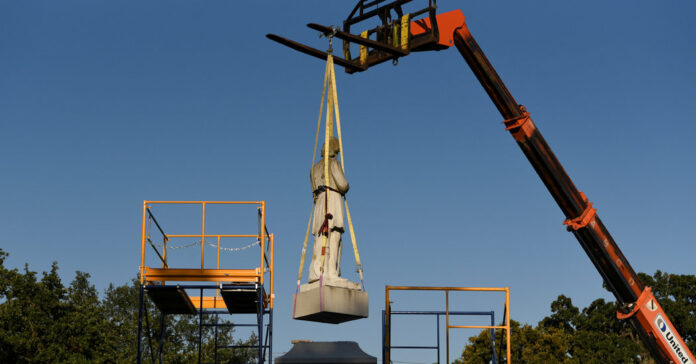Governors and mayors are under pressure to remove statues tied to slavery or colonialism. But finding them a new home might not be easy.

The furor over the death of George Floyd has reignited demands to remove dozens of statues and monuments around the country that glorify Confederate generals, advocates for slavery, defenders of segregation and others whose racial views or conduct are now widely reviled.
That has left a lingering question: What to do with them once they come down?
Officials have removed 106 Confederate symbols since 2015, when a white supremacist gunman killed nine black worshipers at Emanuel African Methodist Episcopal Church in Charleston, S.C., according to Lecia Brooks, outreach director at the Southern Poverty Law Center. Of those 106 symbols, 64 were monuments, and just four of those were relocated.
The vast majority of removed monuments — too large for most museums to accommodate — end up out of sight in storage, Ms. Brooks said.
On Thursday, fury over figures associated with slavery and colonialism continued to simmer. San Francisco took down a statue of Christopher Columbus, while a judge in Richmond, Va., indefinitely extended an injunction barring the governor from removing a statue of the Confederate general Robert E. Lee.
Some of the removals have not been gentle. On Saturday, a statue of John McDonogh, a merchant and trader of enslaved people, was removed from Duncan Plaza in New Orleans and dragged into the Mississippi River. In Richmond, a crowd toppled a statue of Christopher Columbus, set it on fire and threw it in a lake. Another statue of Columbus in Boston had its head lopped off last week.
But most have come down intact. And once monuments have been removed in recent years and months, local leaders have taken a variety of approaches on how to move forward.
In Dallas, city leaders sold a statue of Robert E. Lee, in 2019, at an online auction for $1.4 million. It was later mounted on the putting green of a golf course called Black Jack’s Crossing owned by a Dallas billionaire, Kelcy Warren, near the Mexican border.
In New Orleans, the city opted to put its monument to Mr. Lee in storage. It remains there today.
As Mr. Floyd’s death in Minneapolis gives new life to the movement of removing racially incendiary statues, leaders in cities across the country are taking notice.
Mayor John J. Tecklenburg of Charleston said on Wednesday that the city would take down the towering 110-foot monument to John C. Calhoun, a former vice president and South Carolina senator who was one of the 19th century’s most influential advocates for slavery.
During an interview on Thursday, Mr. Tecklenburg said the city has begun talks with museums and academic institutions to take the statue down and put it in what he said would be proper historical context.
Those talks are continuing, and the city plans to put the statue now at the top of a towering pedestal in storage until a new home is found, he said.
“There were some folks there I know who would have been just as happy if you take it down to just throw it away,” Mr. Tecklenburg said. “But if we don’t keep those stories of how we got to where we are, we lose something.”
Officials in other cities — including Louisville, Ky., Jacksonville, Fla., and Mobile, Ala., — have also removed monuments to Confederate leaders since Mr. Floyd’s death.
In Richmond, Va., protesters have torn down three Confederate statues in recent weeks. In Oregon, demonstrators tore down a monument to Thomas Jefferson.
Ms. Brooks, with the Southern Poverty Law Center, said those actions represent a minority of opinion.
Most people who oppose these monuments in public spaces would prefer to see the statues relocated to a museum or state archive, where curators tell the story of why these monuments were erected in the first place, and why they were removed, Ms. Brooks said.
But even in places where officials have taken down monuments willingly, finding permanent homes for the statues may be difficult, said Sheffield Hale, the president and chief executive of the Atlanta History Center.
Mr. Hale curates a website that makes recommendations for cities that are debating what to do with their controversial monuments.
He said that while many cities would prefer to donate the statues to museums, many curators won’t jump at the chance.
“Most of us have said we’re not interested,” Mr. Hale said. “First of all, they’re toxic in themselves.”
To bring a monument into a local museum could simply turn the controversy away from public officials and toward museum curators, Mr. Hale said.
Even if a museum was willing to take that risk, the statues are often too large to fit comfortably within an exhibit.
Many monuments were built to tower over large public spaces, such as the Marion Square, in Charleston, where the Calhoun statue works as a centerpiece.
Many museums do not have the outdoor space to accommodate them. The statues will also require large information plaques that provide the historical context that they often lack in town squares and in front of courthouses.
Mr. Hale said many cities are finding that keeping a statue in storage, away from public view and out of controversy, may be the best option.
“Putting them in quarantine for a period of years is a fine solution for now,” Mr. Hale said. “Maybe they can be brought out of quarantine a decade or two or three later and we can have a conversation about them. But for now, they’re so toxic.”






